S. Nijalingappa
| S.Nijalingappa | |
|---|---|
 |
|
| 4th Chief Minister of Karnataka | |
|
In office 1 November 1956 – 16 May 1958 |
|
| Governor | Jayachamarajendra Wadiyar |
| Preceded by | Kadidal Manjappa |
| Succeeded by | B. D. Jatti |
|
In office 21 June 1962 – 29 May 1968 |
|
| Governor | Jayachamarajendra Wadiyar Satyawant Mallannah Shrinagesh V. V. Giri Gopal Swarup Pathak |
| Preceded by | S. R. Kanthi |
| Succeeded by | Veerendra Patil |
| Personal details | |
| Born |
10 December 1902 Siddavanahalli, Chitradurga |
| Died | 8 August 2000 (aged 97) |
| Political party | Indian National Congress |
| Religion | Hindu Lingayat |
Siddavanahalli Nijalingappa (10 December 1902 – 8 August 2000, Chitradurga) was a senior Congress politician and the Chief Minister of Karnataka (then Mysore State) between 1956 and 1958 and once again, between 1962 and 1968. He played an important role in the Indian freedom movement as well as in the Karnataka Unification movement.
S. Nijalingappa was born on 10 December 1902 in a middle-class Lingayat family in a village called Haluwagalu(ಹಲುವಾಗಲು) in Harapanahalli taluk, then Bellary district & now in Davangere district. He graduated in arts from the Central College, Bengaluru during this time stayed in Rao Bahadhur Dharmapravartha Gubbi Thotadappa hostel (1921-1924), in 1924 and got his Law degree from the Law College, Poona in 1926. As a child, he was given a traditional education by an old teacher named Veerappa Master. Thus, like the other leaders of the Indian Freedom Movement, he also had a unique blend of both traditional and modern education. The life and the vachanas of Basaveshwar and the philosophy of Shankaracharya, as well as the course of the Indian Freedom Movement and the teachings of Mahatma Gandhi had the utmost effect on his mind.
Nijalingappa attended the Congress sessions as a spectator. It was in 1936, when he came into contact with Dr. N. S. Hardikar, that he began to take an active interest in the organization. He served it first as a volunteer, rising to be the President of the Pradesh Congress Committee and finally the President of the All India Congress Committee in 1968.
He became president of the Mysore Congress and was also a member of the historic Constituent Assembly from 1946 to 1950. Later, he was elected as a member of the first Lok Sabha from the Chitaldrug constituency (now Chitradurga) in 1952.
...
Wikipedia
